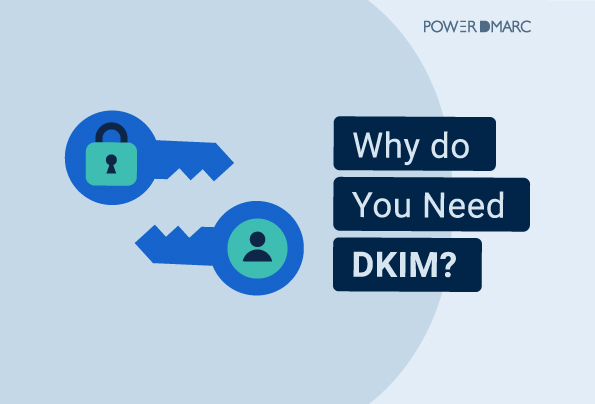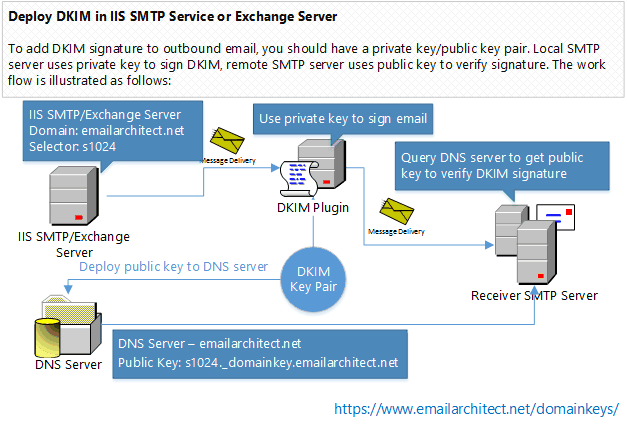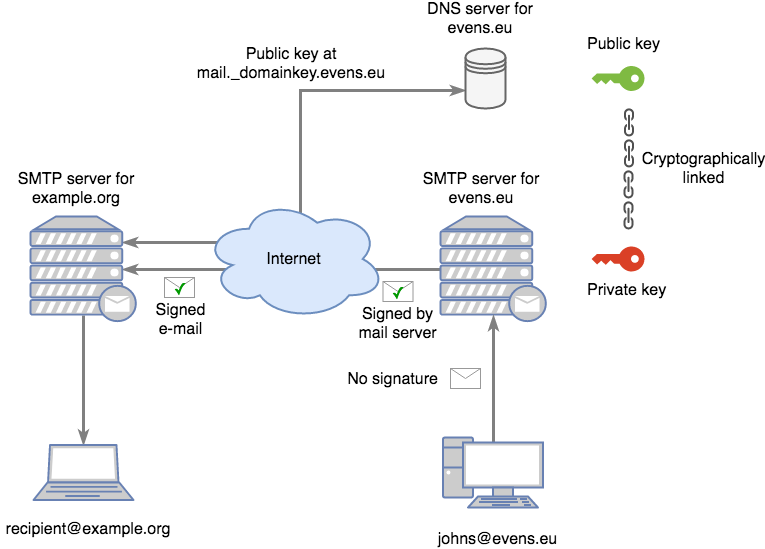As a brief overview of the set up process, DKIM relies on asynchronous encryption, so it works with any tool developed for this type of use. The first step in setting up DKIM for your business is to generate a private/public key pair. Next, the public component of the key needs to be a TXT record assigned to the domain used as.
- DKIM Software and Services Deployment Reports These are status reports from DKIM developers. The reports are listed exactly as provided and have not been independently validated.
- DKIM Wizard This wizard will allow you to easily create a public and private key pair to be used for DomainKeys and DKIM signing within PowerMTA™. The key pair will be used for both DomainKeys and DKIM signing.Policy records are no longer included as they are part of the deprecated DomainKeys, and not DKIM. Domain name of the 'From:' header address, not the SMTP 'MAIL FROM'.
Now you can quickly view your DomainKeys, DKIM, and SPF validity, and SpamAssassin score in one place.Just send an email to any address @dkimvalidator.com. Then check here to see the results.
Here is a random address that you can use:
This is useful for verifying the end-to-end functionality of your DKIM and SPF configuration,as well as your actual SpamAssasin score. Since your email is sent through regular mail servers,all of the headers that these tools see are the same as your email recipients will see.

Configuring DKIM from scratch is difficult since it involves changes to your DNS configuration.DNS records are heaviliy cached, so making changes to the DNS configuration often involves waitingfor hours between each test. This tool attempts to look up DKIM records directly from yourauthoritative server on each tests as a way to try to minimize that delay.
A few quick notes about how this works:
- Messages sent to any @dkimvalidator.com address are routed to our Mandrill Inbound mail account
- Mandrill submits the email messages to our server where it is saved for the other tools to read
- We use the Perl Mail::DKIM::Verifier package to display DKIM information
- We use the Perl Mail::SPF package for information about SPF validity
- We use the Perl Mail::SpamAssassin package for SpamAssassin results
- We use the Perl Net::DNS::Resolver::Programmable for some more detailed DNS Lookups
Our SpamAssassin is just a vanilla installation with nothing extra installed.sa-update is run dailyso that the SpamAssassin rules should always be current.
It will accept messages sent to anything @dkimvalidator.com. Messages will be deleted a few hoursafter they are received. The message is saved once, and the tests are performed each time you loadthe page. This gives you the opportunity to change your DNS records and check the message againwithout having to resend the message. We try to lookup DKIM and SPF records directly from theauthoritative servers whenever possible.
If you have any questions, comments, or concerns, please feel free to Contact Us
Article overviewHelp article
One of the applications of the TXT record is the so called DKIM record (DomainKeys Identified Mail). In this article we'll show you how to configure a DKIM record for your domain in your TransIP control panel.

DKIM is used to check the validity of the sender of emails. A digital signature is accompanied with sent emails, which is checked by the key that's included in the value of the DKIM record.
Where do I add a DKIM record?

You can add all your DNS records easily and free of charge via your control panel. Go to the 'Domain & Hosting' tab and select the domain in the left column for which you want to set the DKIM record (don't check the box).
Now scroll to 'Advanced Domain Settings', followed by 'DNS'. If you do not see this yet, first click the switch behind 'TransIP settings' so the TransIP settings are switched off. The DNS records of your domain name will become visible, after which you can change them at will.
How do I set a DKIM record?
You can see an example of a DKIM record in the image above.
Take note: When you're actively using a Web Hosting service or our VPS Mail service, you can use our very own DKIM records.

If you're sending email with your own mail server, you will first need to install and configure DKIM yourself. Keep in mind that we do not offer direct support on the installation and configuration of DKIM. There is plenty of online documentation on this process however.
Once you've configured DKIM on your own mailserver, you can use this DKIM generator to create your own DKIM record and matching keys. The first box is where you enter your domain name. The second box is for the Selector, where you enter the name of the DKIM record (such as key1).
Next, choose a Key size in bits and press 'Create keys'. The public and private key of the DKIM record will then be shown, followed by the actual DKIM record as you can see below.
Name
Generate Dkim Key
The full name of the DKIM record from our example is key1._domainkey.transiptutorials.com. 'key1' is the Selector, wheras _domainkey states that we want to enter a DKIM key in the value of the record.
Using our example, we only enter key1._domainkey in the 'Name' field. Our DNS software automatically adds the root domain in the background.
TTL
Free Dkim Record Generator
The 'TTL' of a DNS record determines how long the record can remain in the cache. We recommend keeping the TTL low, for example at 1 or 5 minutes.
Type
Because a DKIM record is a variation on the TXT record, we choose 'TXT' under 'Type'.

Value
- We start the value of the DKIM record we created with v=DKIM1; . This means we're using DKIM version 1.
- Next up is k=rsa, where 'k' means we're entering a Key and 'rsa' is the default Key type.
- Lastly we're entering the Public Key, designated by 'p=', followed with the full Public Key.
The image above shows the DKIM record we've created again. The full input of the value of the DKIM record in the control panel is as follows:
Take note: When entering your DKIM record, it is important that you do not copy the quotation marks (') at the beginning and the end of the value. The same applies to backslashes ( ). The quotation marks are added to the background by our DNS software; the backslashes are unnecessary.
Setting DKIM records for subdomains
If you wish to use a DKIM record for a subdomain, you need to add the subdomain after the key:
key1._domainkey.subdomain
Free Dkim Generator Download
As with entering a DKIM record for root domains, you do not need to add the root domain to the subdomain this way. Our DNS software automatically adds the root domain in the background.
Free Dkim Generator
This article has discussed the setting of a DKIM record. For a general explanation about DNS records and entering them, see the article ‘DNS and nameservers'.
If you want to know more about setting DNS records for your Web Hosting service, use the article 'The DNS settings of my web hosting package'.
Should you have any questions left regarding this article, do not hesitate to contact our support department. You can reach them via the ‘Contact Us’ button at the bottom of this page.
If you want to discuss this article with other users, please leave a message under 'Comments'.
